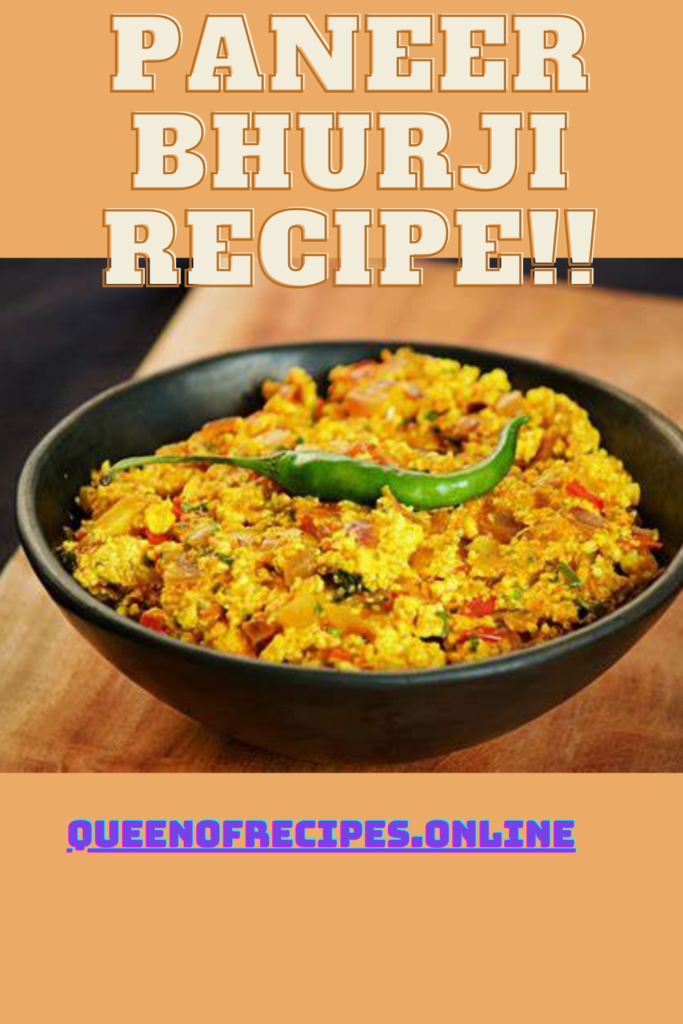Table of Contents
About Paneer Bhurji.
Paneer Bhurji is a delightful and savory Indian dish made from crumbled paneer, a fresh Indian cottage cheese. The term “bhurji” refers to the technique of scrambling or stir-frying, and in this context, it involves cooking crumbled paneer with an aromatic blend of spices, onions, tomatoes, and herbs. Paneer Bhurji is known for its quick and simple preparation, making it a popular choice for breakfast, brunch, or a quick weeknight meal. Its rich, spicy flavors and creamy texture make it a favorite among both vegetarians and non-vegetarians alike. It can be enjoyed with various Indian bread like roti, paratha, or as a filling for sandwiches and wraps.
Ingredients:
- 250 grams of paneer (Indian cottage cheese), crumbled
- 1 medium-sized onion, finely chopped
- 1-2 green chilies, finely chopped (adjust to your spice preference)
- 1 large tomato, finely chopped
- 1/2 teaspoon cumin seeds
- 1/2 teaspoon turmeric powder
- 1 teaspoon red chili powder (adjust to your spice preference)
- 1 teaspoon garam masala
- 1/2 teaspoon cumin powder
- 1/2 teaspoon coriander powder
- Salt to taste
- 2 tablespoons cooking oil or ghee (clarified butter)
- Fresh coriander leaves for garnish
Instructions:
- Prepare the Ingredients:
- Crumble the paneer and set it aside.
- Finely chop the onion, green chilies, and tomato.
- Sauté the Onions and Cumin Seeds:
- Heat oil or ghee in a pan over medium heat.
- Add cumin seeds and let them splutter.
- Add the chopped onions and green chilies. Sauté until the onions turn translucent.
- Add Tomatoes and Spices:
- Add the chopped tomatoes and cook until they soften and the oil starts to separate.
- Spice it Up:
- Reduce the heat to low and add turmeric powder, red chili powder, cumin powder, coriander powder, garam masala, and salt. Mix well and cook for a minute or two to blend the flavors.
- Add Crumbled Paneer:
- Add the crumbled paneer to the pan and gently mix it with the tomato and spice mixture. Be careful not to break the paneer pieces too much.
- Cook and Garnish:
- Cook for a few more minutes, allowing the paneer to absorb the flavors. You can adjust the consistency with a splash of water if needed.
- Garnish with fresh coriander leaves.
- Serve Hot:
- It is best enjoyed hot and can be served with roti, paratha, or as a filling for sandwiches or wraps.
- Optional Variations:
- You can enhance the flavor by adding chopped bell peppers, peas, or even spinach to the dish.
It is a quick and easy dish that’s packed with flavor. Customize the spice level to suit your taste and enjoy this classic Indian cottage cheese stir-fry at home!


Nutritional Value.
The nutritional value of it can vary depending on the recipe and portion size, but here’s a general overview of its approximate nutritional content per serving (approximately 1 cup):
- Calories: Paneer Bhurji typically contains around 250-300 calories per serving.
- Protein: This dish is rich in protein, with one serving providing approximately 15-20 grams of protein. The primary source of protein is the paneer (cottage cheese).
- Fat: Paneer Bhurji can be moderately high in fat, with a serving containing around 15-20 grams of fat. The fat content is influenced by the use of oil or ghee for cooking.
- Carbohydrates: It contains a moderate amount of carbohydrates, typically around 10-15 grams per serving. These carbohydrates come from ingredients like onions, tomatoes, and spices.
- Fiber: Paneer Bhurji is not particularly high in fiber, but it may contain about 2-3 grams of fiber per serving, depending on the vegetables used.
- Vitamins and Minerals: The dish provides essential vitamins and minerals, including vitamin C, vitamin A, calcium, and iron from ingredients like tomatoes and paneer.
- Sodium: The sodium content can vary based on the amount of salt added during cooking. It’s advisable to use salt in moderation for those watching their sodium intake.
It’s important to note that these values are approximate and can vary based on factors such as the recipe, portion size, and specific ingredients used. Additionally, Paneer Bhurji can be a nutritious choice, especially for those looking to increase their protein intake, but it’s essential to be mindful of portion sizes and the use of cooking fats to manage overall calorie and fat intake.
Health Benefits.
Paneer Bhurji offers several health benefits due to its nutritious ingredients and preparation. Here are some of the health benefits associated with it:
- Rich in Protein: Paneer, the primary ingredient in Paneer Bhurji, is a rich source of protein. Protein is essential for muscle repair, tissue development, and overall body function.
- Calcium for Bone Health: Paneer is also a good source of calcium, vital for maintaining strong bones and teeth.
- Vitamins and Minerals: The dish contains essential vitamins and minerals, such as vitamin C, vitamin A, iron, and potassium, derived from ingredients like tomatoes and spices.
- Weight Management: The high protein content in it can promote a feeling of fullness and help control appetite, making it a potentially satisfying option for those looking to manage their weight.
- Balanced Nutrients: The combination of paneer, vegetables, and spices provides a balanced mix of nutrients, including fiber from vegetables and various vitamins and minerals from the ingredients.
- Vegetarian Protein Source: It is an excellent protein-rich option for vegetarians, offering an alternative to meat-based dishes.
- Digestive Health: Spices used in Paneer Bhurji, such as cumin and coriander, may have digestive benefits and help improve overall digestive health.
- Customizable Spice Level: The spiciness of it can be adjusted to suit individual preferences, allowing people to enjoy the health benefits of spices without excessive heat.
- Versatile Dish: It is versatile and can be enjoyed as a breakfast, lunch, or dinner option, offering flexibility in meal planning.
- Moderate Calories: When prepared with moderation in fats like oil or ghee, Paneer Bhurji can be a moderately calorie-controlled dish, suitable for various dietary plans.
It’s essential to prepare Paneer Bhurji using a moderate amount of cooking fats and be mindful of portion sizes to maximize its health benefits while maintaining a balanced diet.
Tips and Tricks.
Here are some tips and tricks to make delicious Paneer Bhurji:
- Use Fresh Paneer: Start with fresh and high-quality paneer for the best texture and flavor. You can even make paneer at home for a fresher taste.
- Crumble Paneer Gently: When crumbling paneer, do it gently with your hands to maintain a slightly crumbly texture. Avoid over-crushing it into a paste.
- Sauté Onions Well: Sauté the chopped onions until they turn translucent and start to caramelize slightly. This adds a sweet and savory flavor base to the dish.
- Balanced Spices: Adjust the spice level to your taste. You can control the heat by varying the amount of red chili powder and green chilies.
- Tomatoes for Moisture: Tomatoes not only add flavor but also provide moisture to the dish. Cook them until they soften and the oil starts to separate for the best taste.
- Add Vegetables: You can enhance the nutrition and flavor by adding finely chopped vegetables like bell peppers, peas, or spinach.
- Use Ghee for Flavor: For a richer flavor, consider using ghee (clarified butter) instead of regular cooking oil.
- Garnish with Fresh Herbs: Garnish Paneer Bhurji with fresh coriander leaves for a burst of freshness and color.
- Serve Hot: It is best enjoyed hot off the stove. Serve it immediately to savor its delicious flavors.
- Variations: Experiment with variations like adding spices such as kasuri methi (dried fenugreek leaves) or a touch of cream for a different twist.
- Pairing: Serve it with Indian flatbreads like roti, paratha, or as a filling for sandwiches, wraps, or dosas.
- Leftovers: If you have leftovers, store them in an airtight container in the refrigerator. Reheat gently on the stove or in the microwave when ready to enjoy.
With these tips and tricks, you can make a flavorful and satisfying Paneer Bhurji that suits your taste preferences.


Serving Suggestions.
Paneer Bhurji is a versatile dish that can be served in various ways. Here are some serving suggestions for Paneer Bhurji:
- Roti or Paratha: Serve it with freshly made roti (Indian flatbread) or paratha (flaky, layered bread). It’s a classic and delicious combination.
- Naan: Enjoy Paneer Bhurji with soft and fluffy naan bread for a delightful meal.
- Toast or Sandwich: Use Paneer Bhurji as a filling for sandwiches or toast. It makes a tasty and protein-packed breakfast or snack.
- Dosa or Uttapam: Stuff dosas (thin crepes) or uttapam (thick, savory pancakes) with Paneer Bhurji for a South Indian twist.
- Rice: Pair Paneer Bhurji with steamed rice or jeera rice (cumin-flavored rice) for a satisfying meal.
- Wrap or Burrito: Wrap Paneer Bhurji in tortillas or flatbreads with some fresh veggies for a fusion-style wrap or burrito.
- Salad: Top a green salad with warm or cold Paneer Bhurji for a nutritious and protein-rich salad bowl.
- Burger: Create a Paneer Bhurji burger by placing it between burger buns with lettuce, tomatoes, and your favorite condiments.
- Side Dish: Serve it as a side dish alongside other Indian curries and dishes as part of a larger Indian meal.
- Garnish: Garnish Paneer Bhurji with fresh coriander leaves, chopped green chilies, or a squeeze of lemon juice for added freshness and flavor.
Feel free to mix and match these serving suggestions to create a meal that suits your preferences and dietary choices. Paneer Bhurji’s versatility makes it a great option for various occasions and meal plans.
FAQs.
What makes Paneer Bhurji creamy?



Paneer Bhurji can achieve a creamy texture through a combination of factors:
Fresh Paneer: Using fresh and soft paneer (cottage cheese) adds a creamy and slightly crumbly texture to the dish.
Cooking Method: The sautéing and simmering of onions, tomatoes, and spices create a flavorful base. Additionally, the release of natural moisture from these ingredients contributes to the creaminess.
Optional Cream or Yogurt: Some recipes call for the addition of a small amount of cream or yogurt, which further enhances the creaminess and richness of the dish.
By incorporating these elements, Paneer Bhurji achieves its desirable creamy consistency while maintaining a balance of flavors and textures.
Can I make Paneer Bhurji with tofu?



Yes, you can make a tofu-based version of Paneer Bhurji, often referred to as “Tofu Bhurji.” To do so, crumble firm tofu and use it as a substitute for paneer. The cooking method remains largely the same, including sautéing onions, tomatoes, and spices. Tofu Bhurji offers a vegan and dairy-free alternative to the traditional dish, and it’s a versatile option for those who prefer plant-based protein sources.
What are the variations of Paneer Bhurji?



Paneer Bhurji is a versatile dish, and there are several variations to suit different tastes and preferences:
Veggie Paneer Bhurji: Add finely chopped vegetables like bell peppers, peas, carrots, or spinach to enhance the nutritional content and flavor.
Spicy Paneer Bhurji: Adjust the spiciness by varying the amount of red chili powder and green chilies used, catering to your heat tolerance.
Creamy Paneer Bhurji: Incorporate a bit of heavy cream or yogurt during cooking for a creamier texture and richer taste.
Herb-Infused Paneer Bhurji: Experiment with fresh herbs like cilantro, mint, or fenugreek leaves (kasuri methi) to impart unique flavors to the dish.
Regional Variations: Different regions in India have their own takes on Paneer Bhurji, using varying spice combinations and ingredients to create regional specialties.
Nutty Paneer Bhurji: Add crushed nuts like cashews or almonds for added richness and a delightful crunch.
These variations allow you to tailor Paneer Bhurji to your liking, making it a versatile and customizable dish.
How can I store leftover Paneer Bhurji?



To store leftover Paneer Bhurji:
Allow it to cool to room temperature. Do not leave it out at room temperature for an extended period.
Transfer the Paneer Bhurji to an airtight container to prevent moisture loss and refrigerator odors from affecting its taste.
Store it in the refrigerator for 2-3 days. Reheat gently on the stovetop or in the microwave before serving.
Proper storage helps maintain its flavor and texture for reheating and enjoying later.

